In the relentless pursuit of better sleep, clinicians often navigate a labyrinth of treatment options to address insomnia, a prevalent sleep disorder affecting millions worldwide. Among the arsenal of pharmaceutical interventions, Zopiclone emerges as a notable contender, offering relief to individuals grappling with sleep disturbances. Zopiclone, a non-benzodiazepine hypnotic agent, operates by enhancing the activity of the inhibitory neurotransmitter gamma-aminobutyric acid GABA in the central nervous system, promoting sedation and sleep induction. Its mechanism of action, akin to benzodiazepines, elicits a rapid onset of action, making it an appealing choice for short-term management of insomnia characterized by difficulty falling asleep or maintaining sleep continuity. Within the realm of clinical practice, Zopiclone finds its niche primarily in short-term management strategies for insomnia, particularly when non-pharmacological interventions yield insufficient results or when immediate relief is paramount. Clinicians often prescribe Zopiclone cautiously, mindful of its potential for tolerance, dependence, and rebound insomnia upon discontinuation.

Therefore, its use typically aligns with short-term treatment goals, spanning a few days to a maximum of two weeks, to mitigate the risks associated with prolonged usage. Moreover, clinicians exercise prudence in selecting appropriate candidates for Zopiclone therapy, considering factors such as age, comorbidities, concurrent medication use, and history of substance abuse, to optimize safety and efficacy outcomes to buy zopiclone online. Despite its efficacy in facilitating sleep initiation and maintenance, Zopiclone is not devoid of adverse effects. Common side effects encompass drowsiness, dizziness, dry mouth, and altered taste perception, which may impede daytime functioning and quality of life. Furthermore, rare but serious adverse reactions, including paradoxical reactions, amnesia, and respiratory depression, underscore the importance of judicious prescribing practices and vigilant monitoring during Zopiclone therapy. Clinicians remain vigilant in educating patients about potential side effects, fostering realistic expectations, and emphasizing the importance of adhering to prescribed dosages and durations to mitigate adverse outcomes. In the landscape of pharmacotherapy for insomnia, Zopiclone stands alongside other hypnotic agents, each bearing its unique profile of efficacy, safety, and tolerability. Comparative studies have scrutinized Zopiclone against alternative treatments, such as benzodiazepines, non-benzodiazepine hypnotics, and sedating antidepressants, elucidating nuances in their clinical utility and risk-benefit profiles.
Such comparative analyses inform evidence-based decision-making, enabling clinicians to tailor treatment regimens to individual patient needs while navigating the complex interplay of efficacy, safety, and tolerability considerations. Beyond pharmacological interventions, holistic management approaches for insomnia encompass cognitive-behavioral therapy for insomnia CBT-I, sleep hygiene education, relaxation techniques, and mindfulness-based interventions. As such, clinicians adopt a patient-centered approach, engaging in shared decision-making and collaborative goal-setting to empower individuals in their quest for restorative sleep and enhanced quality of life. Zopiclone occupies a valuable position in the armamentarium of pharmacological options for managing insomnia within clinical practice and what is stronger than zopiclone. Despite its efficacy in promoting sleep, clinicians wield it judiciously, mindful of its potential for adverse effects and dependence. By integrating Zopiclone with non-pharmacological interventions and adopting a patient-centered approach, clinicians navigate the complex landscape of insomnia management, striving to unlock the elusive gateway to restorative sleep and improved well-being.
